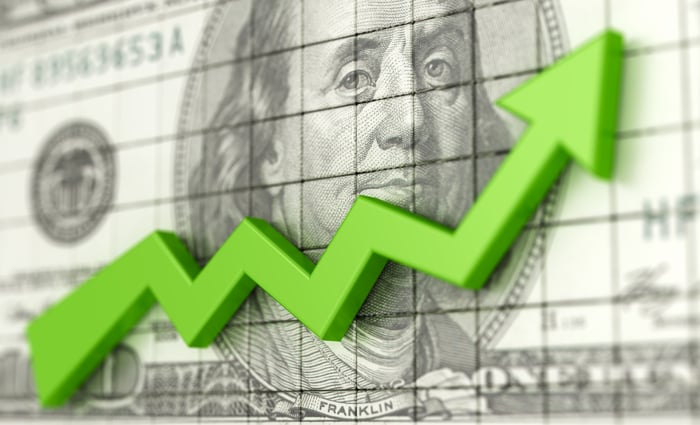One of the most high-profile public listings to hit the market this year will no doubt be Coinbase Global, the leading cryptocurrency exchange in the U.S. Coinbase announced last week that the Securities and Exchange Commission had approved the company's direct listing, and shares are scheduled to begin trading on the Nasdaq exchange on April 14 using the ticker COIN.
Coinbase has listed 114,850,769 shares of stock, but we don't yet know exactly how many will be available for sale, and the company has yet to reveal a proposed stock price. Coinbase is valued at roughly $68 billion on the private markets, but that rises to more than $100 billion when including Coinbase's fully diluted share count.

Image source: Getty Images.
What do they do?
While cryptocurrencies like Bitcoin (BTC 0.44%) have surged in popularity in recent years, they're still not widely available. For the majority of cryptocurrency enthusiasts, this means turning to a platform that allows the buying and selling of these digital currencies. That's where Coinbase comes in.
The company offers an exchange to make it easy for the average investor to buy cryptocurrency, as well as a digital wallet to store it in. It doesn't stop there. For more-advanced users, Coinbase Pro offers advanced charts and more-complicated trading options.
Coinbase boasts more than 56 million individual users, 7,000 institutions, and 115,000 partners in over 100 countries, giving the platform an unmatched ecosystem that caters to every level of cryptocurrency enthusiast.
Lastly, there have been a number of high-profile hacks that have cost cryptocurrency owners billions in lost digital coin and caused bankruptcy for the exchanges. Coinbase has pioneered industry-leading security practices for safeguarding crypto assets and has avoided the fate of some of its less security-minded rivals. The company says its platform has never been hacked.

Image source: Getty Images.
A breakout year
For the fiscal year ended Dec. 31, 2020, Coinbase reported revenue of $1.14 billion, up 139% from 2019. This helped drive net income to $322 million, up from a loss of $30 million in 2019. Adjusted EBITDA was even more impressive, growing more than 2,000% to $527 million.
The company's customer metrics from 2020 were equally compelling. To close out the year, Coinbase reported verified users of 43 million, up 34%, while the number of monthly transacting users soared 180% to 2.8 million. This drove the company's assets on platform to more than $90 billion, up 432% from roughly $17 billion in 2019. Trading volume also increased substantially to $193 billion, up 142% from just $80 billion.
Growth is accelerating
Coinbase released preliminary results for its 2021 first quarter on Tuesday, and the numbers were mind-boggling. Revenue surged to $1.8 billion, a ninefold increase from $190.6 million in the prior-year quarter, while tripling sequentially and exceeding its revenue for all of last year. Net income also soared and is expected to be in a range of $730 million to $800 million, which will represent an increase of nearly 2,300% at the midpoint of its range.
The cryptocurrency exchange reported verified users of 56 million, up from 43 million to close out 2020, an increase of more than 30% in the past three months alone. Growth is clearly accelerating, as its most recent user growth was on top of a 34% increase for all of last year. Monthly transacting users also surged, more than doubling to 6.1 million, up 118% from the 2.8 million it had at the end of 2020.

Image source: Getty Images.
The IPO alternative
Coinbase executives chose to forgo an initial public offering, the traditional route to public markets, opting instead for a direct public offering (DPO). This alternative offers several advantages to the more-frequently taken path.
As part of the IPO process, companies hire investment bankers to handle the public offering, acting as the intermediaries with institutional investors, while also helping to set the stock price by determining what investors are willing to pay for the shares.
As part of the proceedings, management embarks on a road show, which is a series of financial presentations made to the investment community. The purpose is to explain the company's business model, providing its operating history and future opportunities, and estimating its target market. This all helps drum up interest, and increases demand for the stock before it begins trading.
A company opting for a DPO typically isn't looking to raise capital to fund its ongoing operations, so it doesn't need to issue new shares. Going public using this process allows early investors and company insiders to cash in on some of their investment, as they can sell shares on the first day of trading without being handcuffed by the typical lockup period. It also prevents the dilution that occurs with a traditional IPO.
By choosing a DPO, the company takes on more of the preparation (and the risk) itself. There are other benefits, however, as the move can save the company hundreds of millions of dollars compared to the typical IPO, which generally costs between 3.5% and 7% of the gross IPO proceeds.
Should investors cash in?
It's important to note that the majority of IPOs and other new listings are inherently more risky than investing in established public companies. Add in the volatility and uncertainty related to the future of cryptocurrency, and the higher risk profile becomes all the more clear.
That said, for investors willing to accept that additional risk, buying an appropriately sized (read "small") investment in Coinbase could be a way to invest in the booming potential of cryptocurrency.





